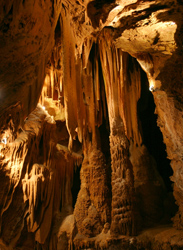Project Success Stories - Looking for climate change clues in the caves
Many people endure difficult and dangerous conditions so that they can experience the unworldly underground atmosphere in caves and the unique mineral formations known as speleothems, such as stalagmites and stalactites. However, as well as attracting caving enthusiasts, speleothems also contain vital information on the climate. Because they are built up from mineral deposits over thousands of years as water slowly drips through porous rocks, they hold layers of information on different atmospheric elements over the ages. One researcher who has been looking into how caves can shed more light on our climate is Spanish paleoclimatologist David Dominguez-Villar. He has just completed a two-year research project monitoring caves in Spain, France, Slovenia and two in the United Kingdom, working with local researchers at each site. 'We were trying to understand if we could see evidence of on-going climate change in different cave environments across Europe,' he says. 'Caves are unique environments as they keep a steady temperature. This means they are a good guide to how the climate is changing in the long term.' An archive of the climate He explains how the speleothems within caves can provide a climate proxy - an archive of past changing conditions over the ages - giving scientists similar data to that from ice-cores drilled into glaciers found in the Earth's polar regions. 'Caves have several advantages over ice cores,' says Mr Dominguez-Villar who carried out the project whilst doing a fellowship at the University of Birmingham (UK). 'They are found everywhere, which means that they can tell us about climate changes across a wide geographic spread, and they are much more accessible because you don't have to go to the Poles.' The stalagmites found in caves enable researchers to gain high-resolution ¬information as they are able to take measurements much more often than in other archives due to recent technical advances, obtaining not only an accurate climate proxy but also resolution even in a sub-annual scale. Speleothems can also be accurately dated over the last few hundred thousand years - the timescale known as the Quaternary period - using the dating technique of uranium-thorium. In addition, stalagmites are particularly useful for palaeoclimate applications because of their relatively simple geometry and because they contain several different climate proxies, such as oxygen and carbon isotopes, or trace elements - impurities in the carbonate stalagmites. These can provide clues to past precipitation, temperature, and vegetation changes over the last 500 000 years or so, explains Mr Dominguez-Villar. This is vital information for scientists studying climate change, because knowledge of past climate variability and its causes is critical to understanding current changes and predicting future trends. Greater insight With interest in climate change growing in many different sectors, more accurate data on climate changes in the past is needed by scientists. 'Many researchers have wanted to use caves as climate archives, but because the surface-cave interactions were not properly known it has been difficult to use such data up till now. We set out to discover how temperature changes are transferred to cave environments,' he says. Mr Dominguez Villars says that thanks to the project, scientists now have 'a major update' in the physics of caves which was last looked into seriously in the 1970s. 'The project has helped us to really understand the process a lot better now,' he says. 'The mechanisms are very complicated, but we now have a much better understanding of how temperatures are transferred into caves and we built models based on the data we collected at each site,' he adds. However, there were certain challenges to overcome before accurate data could be collected. The atmosphere and processes in each cave are unique so they each need to be monitored individually, he explains. Only when the characteristics of each cave are known can meaningful climate models be made. It can take years or decades before changes in the surface temperature changes are transferred to cave environments. 'We found that the depth of any given cave is a major factor in how soon the temperature changes are transferred,' he says. For the Slovenian cave, for instance, there was around a 20-year delay before increasing temperatures on the surface can be seen underground, while changes were transferred only after some years in the selected Spanish, French and UK caves, which where shallower. The team also discovered that another key element affecting the transfer of temperatures is changes in land use on the surface. 'At the Spanish cave we found that cooling had taken place, which we found was due to changes in the forest cover on the surface,' he says. 'This is critical in Europe as there have been lots of changes in how land is used in the last few decades and this means the vegetation cover has changed dramatically.' Future developments Mr Dominguez-Villar is currently writing an academic paper on the findings from the project, which was funded through a fellowship under the EU's Marie Curie programme which promotes the individual research projects of academics. Meanwhile, the data collected will be built on in future work, he adds, with an on-going effort looking at the differences in past climate changes in northern and southern Europe. He stresses that this work is just a starting point, but he believes it will make a valuable contribution to our knowledge of on-going climate changes. 'The caves can provide us with another archive that shows the climate from a different point of view. This project will be used to better calibrate records by other scientist working in caves. As their data is frequently integrated by modellers, the accuracy improvement provided by the findings of this project will be essential to refine predictions in future climate scenarios,' he concludes.



